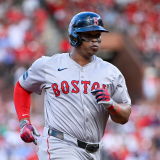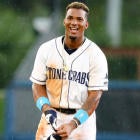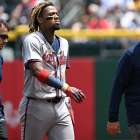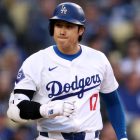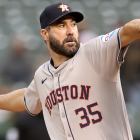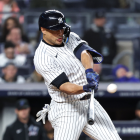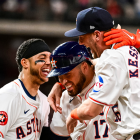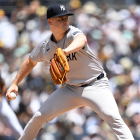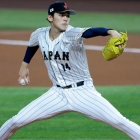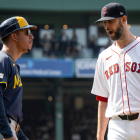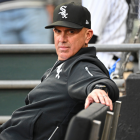With the regular season concluding, we've decided to take a look at each team's future -- not by using a crystal ball or other psychic abilities, but by evaluating their farm systems. Below you'll find our ranking of the top five prospects in the organization -- sorted by perceived future potential -- as well as five other players who fit various categories. Those categories are:
2020 contributor: A player who is likely to play a role for the big-league team next season.
Analyst's pick: A player who is a strong statistical performer and/or whose underlying measures are better than the scouting reports suggest.
Riser: A player on the way up.
Faller: A player on the way down.
One to watch: An interesting player to keep in mind (for whatever reason).
These rankings were compiled after talking with various industry sources about the systems (and players) in question. It should be acknowledged that this process is more art than science, and that there are limits to ordinal rankings. Still, it's an intuitive system, and our hope is that the write-ups will answer any questions by providing additional context and analysis of each player -- such as their pluses and minuses; the risk factors involved; and their estimated arrival date.
One last word on eligibility: we're following MLB's rookie guidelines by disqualifying any player with more than 130 big-league at-bats or 50 innings pitched.
The Rays have perhaps the best system in baseball, led by the game's top prospect.
1. Wander Franco, SS
The best prospect in baseball, Wander Franco has all the makings of a franchise talent.
Franco, who won't turn 19 until March, is a switch-hitting shortstop who split the season between Single- and High-A. He hit .327/.398/.487 with nine home runs and 21 more walks than strikeouts. The only statistical negative to point out is that he required 32 attempts to swipe 18 bases. Otherwise, there's not much to nitpick here.
In addition to the production, Franco checks all the boxes for projection. He has all the innate characteristics required to be an impact-level player, ranging from his strength to his speed to his throwing ability and so on.
One rival talent evaluator joked during the summer that Franco probably could've held his own against big-league pitching. It wasn't meant as a serious evaluation, per se, but it speaks to Franco's polish and talent level all the same. Even if he has to move off shortstop, he might end up as one of the best players in baseball.
2. Brendan McKay, LHP/DH
Brendan McKay, the No. 4 pick in the 2018 draft, just did qualify for this list. He was an inning short of the limit -- and, frankly, there was some consideration given to ruling him ineligible since he did make a few appearances as a DH.
Indeed, McKay is two-way player who should probably be restricted to the mound. That's where scouts prefer him, and his bat is far enough behind that it's going to be hard to develop him as a hitter without missing out on the value he can provide as a pitcher.
McKay has a three-pitch arsenal: a low-to-mid-90s fastball that generated an absurd amount of in-zone swinging strikes in the minors, a cutter, and a curveball. Each pitch generated at least 20 percent whiffs during his big-league stint, though the opposition (mostly right-handers) slugged .515 against his heater and batted .292 on the curve.
The Rays had McKay consistently work on five days' rest rather than four, and it's to be seen if they change that heading into 2020. He receives high marks for his low heartbeat -- read: calm demeanor -- and the expectation is he'll become a No. 2 or 3 starter with time.
3. Shane Baz, RHP
Sorry Pirates fans, but it must be noted that Shane Baz was yet another piece of the Chris Archer return, alongside outfielder Austin Meadows and fellow starter Tyler Glasnow.
Baz, who turned 20 in June, spent the season in A-ball and showed why he's the most intriguing right-handed prospect in the system. He struck out 87 batters in 81 innings thanks to a broad arsenal that includes multiple above-average offerings, beginning with his fastball and extending to various breaking balls. His changeup still lags, which explains why left-handers were able to succeed against him to the tune of, um ... a .665 OPS.
Baz's delivery does inspire concern about his command, and he set a new career-best by walking just over four batters per nine. There's a chance he ends up in the bullpen or in a hybrid role as a result of the aforementioned platoon and command concerns. But there's a lot to like here and a high ceiling if he's able to smooth out those wrinkles.
4. Vidal Brujan, 2B
The Rays traded one quality second-base prospect in Nick Solak at the deadline, but they held onto another in Vidal Brujan despite teams having interest in acquiring him.
Brujan, 21, split the season between High- and Double-A and hit his first relative speed bump after the mid-season promotion -- meaning he hit just .266/.336/.391 while being three years younger than the league average. Hey, what do you think "relative" means?
The switch-hitting Brujan can really run, and has shown contact and on-base chops throughout his career. There is some thought he may end up in center field, but so far the Rays have played him only on the dirt.
Wherever Brujan does or doesn't play, there's enough of a base and track record of production to envision him becoming an above-average player who makes his big-league debut no later than spring 2021.
5. Ronaldo Hernandez, C
Another popular trade ask, Ronaldo Hernandez didn't have quite as good of a season as Brujan did -- and, frankly, seems more likely to be dealt before reaching the majors.
Hernandez, 22 in November, hit .265/.299/.397 in High-A. He has an aggressive approach at the dish, resulting in a four percent walk rate. Hernandez may still turn into a solid enough hitter thanks to his raw strength and feel for the barrel -- though, obviously, there is some risk that his on-base percentage sinks his overall offensive value.
Defensively, Hernandez remains a work in progress and a substandard framer. He does have a big-time arm and, again, is on the younger side.
If Hernandez puts everything together, he could be a quality two-way contributor. There's also a chance he's just a backup.
2020 contributor: Tyler Zombro, RHP
Originally an undrafted free agent, right-hander Tyler Zombro doesn't scream pitcher of note -- if anything, he looks like a piece of organizational depth due to his lackluster velocity and a recently passed 25th birthday. Yet Zombro's low arm slot creates a lot of deception, and helps generate good movement on his pitches. The Rays had him throw multiple innings in roughly half of his 41 outings this season, suggesting they might use him in a similar role in the majors. Don't be surprised if Zombro ends up in the Show before 2020 is out.
Analyst's pick: Joe Ryan, RHP
Joe Ryan uses his non-fastball offerings about as frequently as Switzerland elects a general -- which is to say, only when necessary. Ryan torched High-A batters despite a fastball-heavy approach, ending up with a 9.33 strikeout-to-walk ratio and 1.42 ERA. Ryan did use his curveball and changeup more often in a brief cameo at Double-A, and it'll be worth watching to see how he adjusts heading forward. Though his pitches have life and he throws a good amount of strikes, it's hard to reconcile his results to date with his arsenal.
Riser: Josh Lowe, OF
Tampa Bay's first-round pick in 2016, Josh Lowe had a resurgent season in Double-A -- both walking and hitting for more power than he had in his two previous full seasons. Lowe can run and can throw and has taken well to center field. The one big question facing him is whether his strikeout rate will balloon too much against big-league pitching. If Lowe can make consistent contact, there's still some star potential here. Presuming he holds his own in Triple-A, he could debut in the majors before the season is out.
Faller: Lucius Fox, SS
Lucius Fox combines a great name with well-above-average wheels. Alas, he hasn't hit since reaching Double-A, hampering his chances of becoming a starting-caliber player. Because Fox can handle shortstop and run well, he could still crack the majors in a reserve capacity -- the Rays, for their part, gave him looks at second and third base this year, seemingly grooming him for such usage.
One to watch: Brent Honeywell Jr., RHP
Brent Honeywell would be near the top of the list due to his intelligence, stuff, and proximity to the majors. But he's missed the past two seasons due to Tommy John surgery and a fractured bone in his elbow, making it tough to rank him. Here's hoping Honeywell makes a full recovery, because he has the potential to be one of the more fun pitchers in the game.







